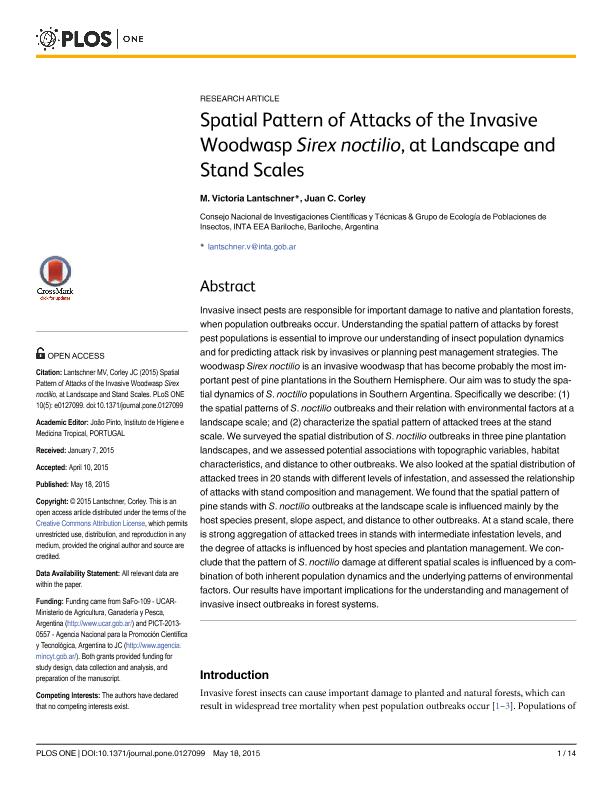Mostrar el registro sencillo del ítem
dc.contributor.author
Lantschner, María Victoria

dc.contributor.author
Corley, Juan Carlos

dc.date.available
2018-05-24T15:41:56Z
dc.date.issued
2015-05-18
dc.identifier.citation
Lantschner, María Victoria; Corley, Juan Carlos; Spatial pattern of attacks of the invasive woodwasp Sirex noctilio, at landscape and stand scales; Public Library of Science; Plos One; 10; 5; 18-5-2015; 1-14; e0127099
dc.identifier.issn
1932-6203
dc.identifier.uri
http://hdl.handle.net/11336/46076
dc.description.abstract
Invasive insect pests are responsible for important damage to native and plantation forests, when population outbreaks occur. Understanding the spatial pattern of attacks by forest pest populations is essential to improve our understanding of insect population dynamics and for predicting attack risk by invasives or planning pest management strategies. The woodwasp Sirex noctilio is an invasive woodwasp that has become probably the most important pest of pine plantations in the Southern Hemisphere. Our aim was to study the spatial dynamics of S. noctilio populations in Southern Argentina. Specifically we describe: (1) the spatial patterns of S. noctilio outbreaks and their relation with environmental factors at a landscape scale; and (2) characterize the spatial pattern of attacked trees at the stand scale. We surveyed the spatial distribution of S. noctilio outbreaks in three pine plantation landscapes, and we assessed potential associations with topographic variables, habitat characteristics, and distance to other outbreaks. We also looked at the spatial distribution of attacked trees in 20 stands with different levels of infestation, and assessed the relationship of attacks with stand composition and management. We found that the spatial pattern of pine stands with S. noctilio outbreaks at the landscape scale is influenced mainly by the host species present, slope aspect, and distance to other outbreaks. At a stand scale, there is strong aggregation of attacked trees in stands with intermediate infestation levels, and the degree of attacks is influenced by host species and plantation management. We conclude that the pattern of S. noctilio damage at different spatial scales is influenced by a combination of both inherent population dynamics and the underlying patterns of environmental factors. Our results have important implications for the understanding and management of invasive insect outbreaks in forest systems.
dc.format
application/pdf
dc.language.iso
eng
dc.publisher
Public Library of Science

dc.rights
info:eu-repo/semantics/openAccess
dc.rights.uri
https://creativecommons.org/licenses/by/2.5/ar/
dc.subject
Landscape Ecology
dc.subject
Forest Insects
dc.subject
Invasive Pest
dc.subject
Insect Outbreaks
dc.subject
Pine Pest
dc.subject
Patagonia
dc.subject
Multiple Spatial Scales
dc.subject
Forest Management
dc.subject.classification
Otras Ciencias Biológicas

dc.subject.classification
Ciencias Biológicas

dc.subject.classification
CIENCIAS NATURALES Y EXACTAS

dc.title
Spatial pattern of attacks of the invasive woodwasp Sirex noctilio, at landscape and stand scales
dc.type
info:eu-repo/semantics/article
dc.type
info:ar-repo/semantics/artículo
dc.type
info:eu-repo/semantics/publishedVersion
dc.date.updated
2018-05-21T17:22:06Z
dc.journal.volume
10
dc.journal.number
5
dc.journal.pagination
1-14; e0127099
dc.journal.pais
Estados Unidos

dc.journal.ciudad
San Francisco
dc.description.fil
Fil: Lantschner, María Victoria. Consejo Nacional de Investigaciones Científicas y Técnicas. Centro Científico Tecnológico Conicet - Patagonia Norte; Argentina. Instituto Nacional de Tecnología Agropecuaria. Centro Regional Patagonia Norte. Estación Experimental Agropecuaria San Carlos de Bariloche; Argentina
dc.description.fil
Fil: Corley, Juan Carlos. Consejo Nacional de Investigaciones Científicas y Técnicas. Centro Científico Tecnológico Conicet - Patagonia Norte; Argentina. Instituto Nacional de Tecnología Agropecuaria. Centro Regional Patagonia Norte. Estación Experimental Agropecuaria San Carlos de Bariloche; Argentina
dc.journal.title
Plos One

dc.relation.alternativeid
info:eu-repo/semantics/altIdentifier/url/http://journals.plos.org/plosone/article?id=10.1371/journal.pone.0127099
dc.relation.alternativeid
info:eu-repo/semantics/altIdentifier/doi/http://dx.doi.org/10.1371/journal.pone.0127099
Archivos asociados
